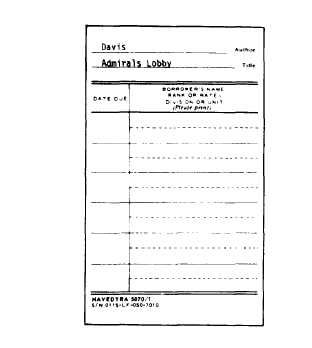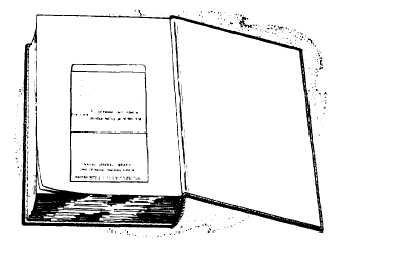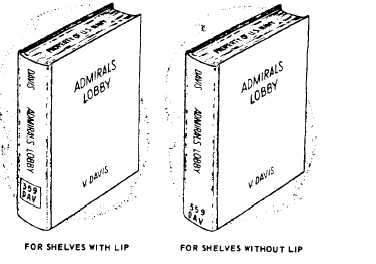U.S. NAVY. Any books received unstamped are
to be stamped immediately.
(3) Prepare a book card by typing the
author’s last name and book title on the
designated lines of the book card. This informa-
tion is readily available from the packing slip,
the catalog cards, and the book, (See figure 8-4.)
(4) Affix the book-card pocket to the page
facing the back cover of the book. Pockets
which are not pressure sensitive should be glued
or pasted. They should not be taped or stapled
to the page. Place the book card in the pocket.
Stamp the pocket with the ship’s property
stamp. (See figure 8-5.)
(5) Prepare a spine label for each book.
Labels for fiction books should include the letter
“F” and the first three letters of the author’s
last name. As desired, “SF” may be used to
designate science fiction books, ‘‘ W“ for
westerns, and “M” for mysteries to assist
patrons in identifying these types of books.
Nonfiction book labels should include the
Dewey decimal class number as given on the
packing slip or catalog cards and the first three
letters of the author’s last name, The finished
label should be affixed (at a uniform height) to
the lower portion of the book’s spine or the
Figure 8-4.-Book card.
Figure 8-5.—Position of book-card pocket in book.
Figure 8-6.-Position of class number on spine of book.
book’s paper cover. Labels for books which are
housed on a shelf with lips should be placed
approximately 2” above the bottom of the book
so the label can be easily seen. Occasionally, due
to the texture of a book’s binding, pressure sen-
sitive spine labels will not adhere to the spine. In
such cases, the spine identification should be
printed directly on the book’s spine with a
library marking pen designed for this job. (See
figure 8-6.)
(6) Books should be protected by encasing
them in plastic book jackets. The book’s paper
cover in the plastic jacket adds colorful eye
8-16





